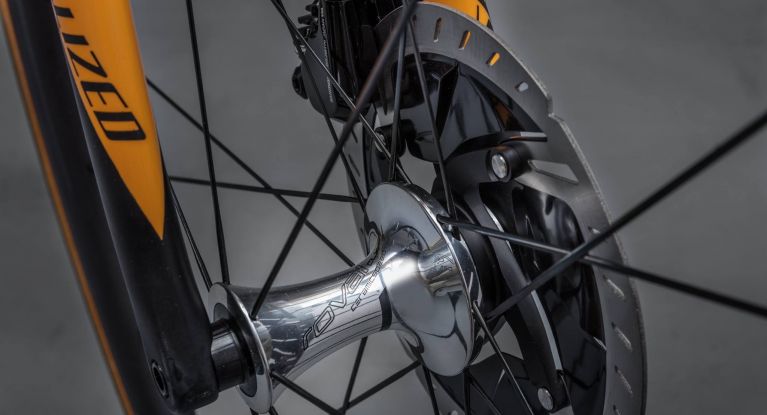
Earlier this week, British Cycling announced that disc brakes will be allowed in all levels of domestic competition in road races and closed circuit events from 1 January 2018. By so doing, they follow in the footsteps of the governing bodies of the USA, Australia and Canada which permit disc brake use in mass-start road races, sharing the objective of increasing the number of people getting out on their bikes, whether recreationally or competitively.
What does it mean?
Until now, the blanket ban on disc brake use in competition has been prohibitive more than anything else. Though they are permitted at sportive events, the ban has prevented owners of disc-equipped bikes from advancing their racing skillset and blocked the UK market for such bikes. This new ruling should see not just a justified surge in the demand for disc-equipped bikes, but also a growth in participation.
“We hope that this decision will encourage more and more people to get involved in competitive cycling.” – Jonny Clay, director of cycling, British Cycling

What are disc brakes?
Fundamentally, disc brakes move the braking force away from the rim and into the centre of the wheel. Rim brakes put immense force on the wheel’s rim which is required to execute three important functions: forming the main structural component of the wheel, the mounting base for the tyre and the braking surface. By moving the braking component to the hub and mounting the brake calliper to the fork and frame close to the axle, you open up a whole host of benefits. Not only do disc brakes provide a great deal more stopping power thanks to their (often) hydraulic system, but they are also more durable and offer the opportunity to optimise wheel design which was before compromised by the obligations of the rim-braking surface.
Why should your next bike have disc brakes?
The disc brake versus rim brake argument is a hot topic in the world of road cycling. Their adoption was relatively quick and pain-free in mountain biking and cyclocross, so why is it taking us lot on the asphalt so long to accept them?
The major advantage of disc brakes is in their stopping power, which is so far above and beyond that of rim brakes. There’s also a myth to be debunked here which is that you can’t feather disc brakes; that they’re either pulled on or not. This is a long way from the reality. We can’t deny that their responsiveness takes some getting used to, especially when coming from rim brakes where you just squeeze the levers and hope you’ll stop in time, but with some practice, you can easily vary the force applied.
If you do a lot of winter riding, or like to venture onto unpaved roads, you’ll find disc brakes make your life a great deal easier. The nature of rim brakes is that they easily become caked with road muck, oil and grit because they are so close to the surface of the road. Disc brakes on the other hand, take the pressure off the rims and away from the road, increasing reliability and preventing undue damage to the wheels.
The bikes
Here at Specialized, we seized upon the disc brake technology, recognising it for what it is as an enabling, safe and ultimately timely addition to the road bike market. Many of the more recent iterations of our bikes were designed specifically for disc brakes, but then had to be optimised for rim brakes to satisfy the suits who banned the technology. The following are just a small selection of our disc-equipped road machines.

The Specialized Venge Vias is one of the models that was built around disc brakes before the ban on professional use came into being. The aerodynamic design was developed in the aptly-named ‘Win Tunnel’ and the process involved computational fluid dynamics, 3D-printed prototypes and real-world rider feedback. The Venge is one of the winningest bikes in pro cycling, poised beneath riders like Peter Sagan and Fernando Gaviria to explosive success. What’s more, if you want to get your hands on a 2018 Venge, you’ll find that every frame in the range is disc-equipped and there is not a single rim-brake option available. That’s progress.
{: 12113, 11012, 12127}

The Specialized Roubaix (men’s) and Ruby (women’s) are most at home on the brutal terrain of northern Europe, taken into battle by the classics specialists every spring and really put through their paces over cobbles and bergs. These typically endurance frames have also found a worthy playground on the potholed and unpaved roads that snake through the British countryside thanks to the innovative Future Shock suspension and durability in all sorts of conditions. Rather like the Venge, the whole Roubaix and Ruby ranges are equipped with disc brakes because, frankly, it just makes sense.
{: 11911, 11917, 6826, 12197, 12211, 11615}

For the discerning urban cyclist or enthusiastic weekend wanderer, the Sirrus fitness bikes are optimised for safe, comfortable and efficient riding. Hugely popular in urban spaces, these bikes are designed to get you from A to B in comfort and confidence, which is why disc brakes are the logical choice. If you commute by bike, you’ll know that the ability to react instantly to hazards is vital, and that’s where disc brakes come into play.
{: 12016, 12002, 11996, 11969, 11983, 11971}
This little selection barely scratches the surface of what we can offer in the disc brake department, and clearly is restricted to bikes for use on the road. What we hope it proves though, is that no matter your level, there is something here for you that will not only inspire confidence, but improve your safety and even efficiency. And who knows, you may just consider racing in light of recent developments and see your general riding experience exceed all expectations.